
The Perfect Baguette
September 15, 2014
By Julie Fitz-Gerald
The quintessential French baguette speaks of time, care and
craftsmanship. It’s caramel-coloured, crumbly crust and fluffy middle
rippled with airy holes is a testament to skilled bakers who spend years
honing their ability to shape, fold and score the dough to perfect
proportions.
The quintessential French baguette speaks of time, care and craftsmanship. It’s caramel-coloured, crumbly crust and fluffy middle rippled with airy holes is a testament to skilled bakers who spend years honing their ability to shape, fold and score the dough to perfect proportions. Despite the simplicity of its four ingredients – flour, water, salt and yeast – the fermentation and baking process is complex, requiring the baker to take into account the weather outside, the temperature within the bakery and the feeling of the dough.
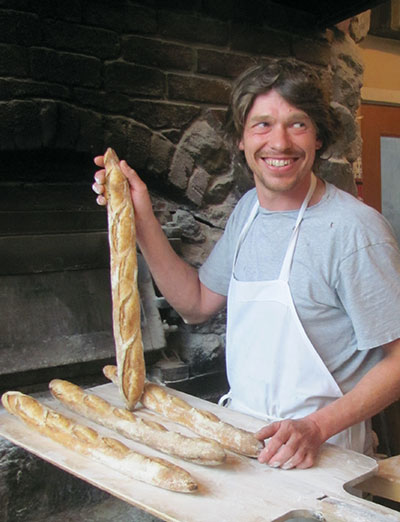 |
|
| Cliff Leir of Fol Epi bakery with some fresh baguettes. All photos courtesy of Fol Epi bakery
|
Once an unstoppable staple in France, the baguette has taken a hit in recent years with the average French person eating only half a baguette a day compared with nearly a whole baguette in 1970 (and more than three a century ago). Despite dipping sales in its homeland, the baguette’s versatility has made it a fan favourite around the world. Whether it’s served as an accompaniment to soups and salads, paired with fine cheeses, or used as the foundation for deserving sandwiches, the baguette is beloved by consumers and has earned its place on bakery shelves.
IT’S ABOUT TIME
The most important component in achieving the perfect French baguette is time. For the past 18 years Louis Andre Joyal has been crafting noteworthy baguettes at La Petite Boulangerie, a Montreal bakery that he co-owns with wife Sylvie Boissonneault. The bakery makes between 1,500 and 1,700 baguettes per week.
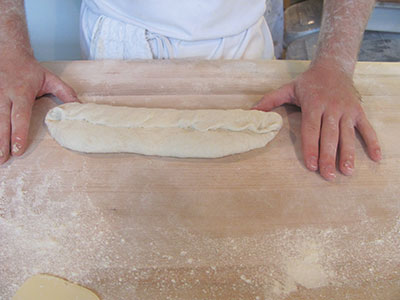 |
|
| Preparing the dough.
|
“I make the dough the day before I’m using it for cooking,” says Joyal. “This way is better because I’m using less yeast and longer fermentation time. The baguettes stay in the fridge at eight degrees Celsius for 16 to 18 hours and that’s what gives more flavour.”
Cliff Leir, proprietor of the popular Fol Epi bakery in Victoria, B.C., agrees that time is crucial when it comes to baguettes. “We have a 15-hour fermentation time,” says Leir. “This allows for enzyme development which breaks down starch structure. In that breaking down there are various labour components – wild yeast, lactic acid production – so, in short, it’s flavour and texture development.”
If one is tempted to rush the process, be warned, the result will be a dense baguette that’s seriously lacking in flavour. Bonjour Brioche in Toronto, Ont., has been serving up mouth-watering French baguettes for 17 years. Henri Feasson co-owns the bakery-restaurant with his wife Lori and they sell about 240 baguettes on an average Saturday.
“The inside of the baguette should be fluffy with some holes and when you taste it you should taste the flavour and the time,” explains Feasson. “You can see the bread has been rested. If you see holes in the dough when you cut it then you’ve done a good job. If it’s too dense then it hasn’t been proofed enough and had the time to relax. It’s basically all about time.”
TAKING SHAPE
Gluten is an important component in a great baguette and is also the reason why baguettes must be shaped twice.
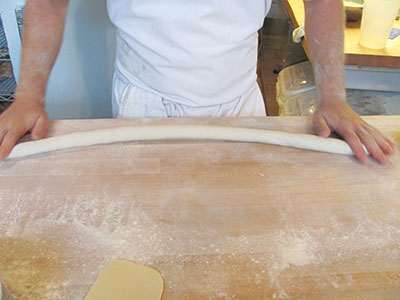 |
|
| Rolling the dough.
|
“You can’t just shape it because the gluten will shrink back like an elastic band, so you have to shape it twice and then put it on the trays,” says Feasson. “The flour has to be a strong wheat flour that’s rich in glutens. That’s what makes your baguette beautiful. Technically, I don’t think anybody can make a baguette or French bread without gluten. It wouldn’t rise; it would only be flat bread.”
Leir uses Red Fife wheat, a type of wheat that set the standard for Canadian wheat cultivation back in the mid-1800s. Sourced from a farmer in Saskatchewan, Leir mills the wheat at his bakery, which is indicative of his “slow food” beliefs and only adds to the flavour of a great product.
“Baguettes are one of the harder breads to learn to fold,” Leir explains. “It always takes a couple months of doing baguettes every day for people to get the right technique. Mixing it to just the right point, having the right kind of flour. While the dough is fermenting we fold it and dump it in one large piece instead of stretching and mutilating it. It needs to be in an oblong shape without breaks so there’s no break in the gluten structure.”
TAKING SHAPE
Shaping the dough into its characteristic oblong shape requires time, patience and practice. Each baguette should measure 350 grams before baking, which will fall to roughly 300 grams after baking. Joyal’s step-by-step process for achieving one of the top-rated artisanal baguettes in Montreal (as determined by the Montreal Gazette) is this: “When we arrive at 12 a.m. we put the dough out for one hour. Then we cut it into a rectangular shape just a little bit. We take the top of the rectangle and put it at the bottom just to make a nice tube and then we let it rest for 30 minutes. After 30 minutes we continue to make the shape of the baguette. The rectangle is folded in one, and the second time we put it in two and make it a bit longer. At that point we let it rest for 45 minutes or until it’s ready, depending on the temperature of the bakery and if it’s winter or summer. It’s not us who decides when the baguette should be cooked; it’s the baguette that decides.”
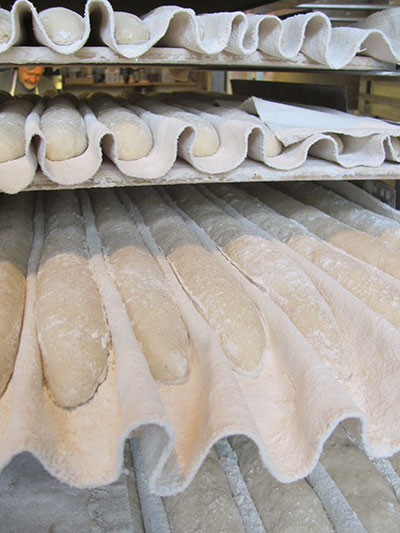 |
|
| The proofing stage |
|
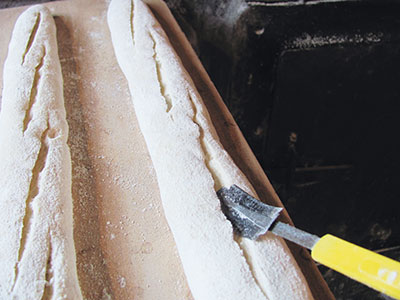 |
|
| Slashing the baguettes |
Before going into the oven, the baguette must be adorned with its signature scoring marks. It is here that bakers can express their style.
“The cuts are the signature of the baker,” says Joyal. “Some make three, some make five or even seven cuts, but for me, to have a nice development of the baguette, three to five cuts are good.”
Leir explains that proper scoring adds a depth of flavour, making the baguette crunchy and delicious: “It’s a technique with a curved razor that runs parallel under the surface of the baguette. It’s shallow and there are usually five cuts and each slash should overlap the other one by a third.”
With the lengthy process nearing completion, the baguette is ready for baking. Depending on the oven, baking temperatures range from 240 to 260 degrees Celsius for approximately 20 minutes. During the first five minutes of cooking time, the bread must be steamed in order to get a delightfully crunchy crust.
“For the first five minutes of cooking we put humidity inside to allow the baguette to expand,” says Joyal. “The humidity wets the dough to make the baguette expand and then the water with the dough will make the caramel colour. Then we open the door of the oven to let the humidity out and make it dry so the crust will finish.”
FEELING YOUR WAY
For many bakers, the process of creating baguettes has as much to do with “feeling” as with following a series of steps. Each day may call for a slight alteration to the process. For Joyal, even emotions can have an effect on the final product.
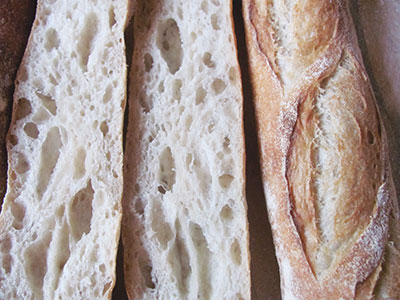 |
|
| The finished product: crumb and crust details
|
“It’s a question of feeling: feeling the dough, feeling the temperature, how you are feeling when you’re making it. When we’re baking, the end product is an extension of our mind,” he explains.
Even for an experienced baker like Joyal, things can sometimes go awry. “It’s a surprise every day when we make bread. It’s not because we don’t know what we’re doing. It’s because a baker needs to be on his toes every day. When we open the fridge to pull out the dough, it’s a surprise. When we put the bread in the oven, it’s still a surprise. After 18 years, it’s still a surprise. I don’t know any baker who says, ‘My bread will be perfect when I cook it.’ We have to be on our toes.”
Feasson agrees that baguettes can sometimes have a mind of their own. “You’re going to make a lot of bad baguettes before you make good ones,” he says. “Even us now, we have days where things go wrong and you have to go back and figure out what happened. The problem with the baguette is that you don’t know until it’s baked. If I had one word it would be ‘time,’” says Feasson.
Perhaps that’s the allure of the baguette. The crunchy, crumbly crust and cream-coloured centre rife with airy hollows can sometimes elude even the most skilled baker. It’s a daily challenge that, when done right, can have the most scrumptious results.
Julie Fitz-Gerald is a freelance writer based in Uxbridge, Ont., and a regular contributor to Bakers Journal.
Print this page
Leave a Reply